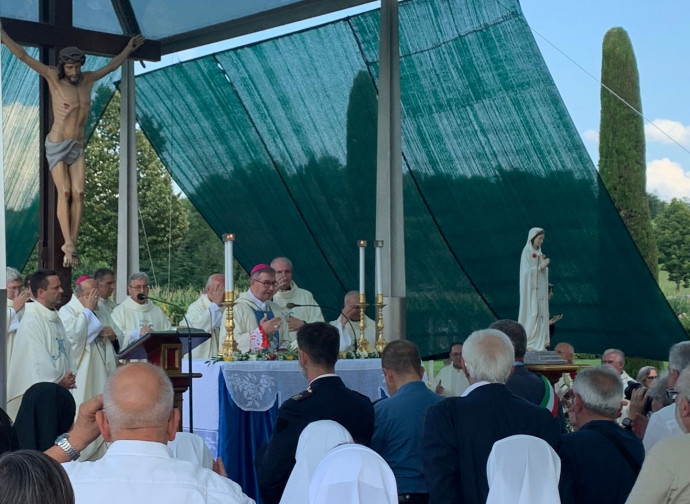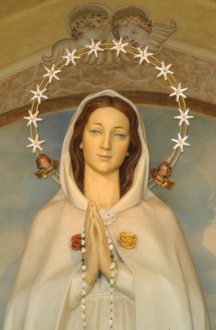Bishop Tremolada: "Mary, Mystical Rose, she’s the beauty needed today"
From the writings of Pierina Gilli one immediately grasps "a certain spirituality of beauty, a fundamental characteristic of the Blessed Virgin." The prophetic significance of the devotion of the three roses for the consecrated and Mary's motherhood towards the sick. The Daily Compass interviews the Bishop of Brescia, Pierantonio Tremolada.

July 13, 2024, will go down in history for the Church; the first feast of Mary, Mystical Rose, which follows the highest recognition (the nihil obstat), in light of the new Norms for proceeding in the discernment of alleged supernatural phenomena, that it is possible to obtain in the ordinary way for apparitions that are still officially presumed (given the fact that only the Pope can exceptionally authorise the initiation of a procedure to arrive at a possible declaration of supernaturalness).
A day of sunshine and grace, almost a foretaste of Paradise which culminated in the solemn 5 p.m. Mass presided over by the Bishop of Brescia, Monsignor Pierantonio Tremolada. The Daily Compass attended the celebration and interviewed the bishop at the conclusion of the liturgical celebration.
Monsignor Tremolada, the decree with which you give the nulla osta to the cult of Rosa Mistica and the spiritual proposal linked to the messages spread by Pierina Gilli, mentions the many fruits born from this devotion. Is there something about these fruits that has struck in particular?
Everything we are witnessing here, the conversions, the prayer, the constant presence of pilgrims, the atmosphere, the fact that the sanctuary has always remained open without a single accident occurring, the attitude of the people who immediately perceive the nature of this place. This is the first thing. The second concerns content. The deeper one goes into the texts written by Pierina, the more one grasps that there is a profound and also particularly contemporary spirituality here. A spirituality of beauty, a fundamental characteristic of the Blessed Virgin, who made herself known here, possible to encounter: this characteristic, in my opinion, is very topical. Today's world is in danger of losing the measure of beauty, the zest for life, the brightness of existence. And there is a need for this.
Our Lady also tells us that beauty is linked to truth.
Yes, beauty and goodness, because truth, in the Christian perspective, coincides with love. It is a love that obviously, to be authentic, must have certain characteristics and must also be expressed in a certain way.
 In the first cycle of apparitions, between 1946-47, the Mystical Rose asked for the three roses "prayer, sacrifice and penance,", these three roses are central to consecrated souls. How relevant is this call almost eighty years later?
In the first cycle of apparitions, between 1946-47, the Mystical Rose asked for the three roses "prayer, sacrifice and penance,", these three roses are central to consecrated souls. How relevant is this call almost eighty years later?
It is very contemporary. Unfortunately, it is evident in the suffering in the Church due to the way some consecrated people behave. And this is a deep wound. It is striking that in the testimony, found in Pierina Gilli's writings, there is a strong insistence for prayer for the consecrated, which keeps them within the truth of their calling, at the service of the Church, with an upright, generous life. I think this is particularly needed.
It’s curious that the cycle regarding these messages was at a time, the 1940s, when vocations were flourishing...
That's right, this is also an aspect. Later vocations and the number of priests were greatly reduced, and this is also a fact that I believe should be interpreted, because it refers to a fact that in some way was foretold.
Did Heaven try to deliver the "medicine" in advance of what would later happen?
Let’s say, it prepared us to face it. Yes, it is like a medicine, because I believe that an authentic Marian cult also has this effect.
In the second cycle, which took place here at Fontanelle di Montichiari, there is a special attention to the sick.
This is another aspect that is typical of Marian piety. Suffering is one of those aspects of life that one cannot be disregarded and that turns into a trial that one must endure. Then it is consoling to know that it can be faced together. There is a motherhood that can be counted on, that can be felt. This is certainly of great value.
During the press conference when you presented the decree, you also stressed the link with your last two predecessors at the head of the diocese of Brescia (Msgr. Giulio Sanguineti and Msgr. Luciano Monari), in light of the change of course on the Mystical Rose from 2001 onward. Can you recall why the case was reopened then, positively?
It was also reopened at the urging of the Holy See. That has to be said and it's good to acknowledge it, also because it means that the devotion to Mystical Rose has always been followed at the level of the Holy See, of the Congregations of the Roman Curia. And I must say that from my own personal experience, the moment I too became interested in this case and began to look into it, I immediately found valuable support in the Congregation for the Doctrine of the Faith. We also formed an international commission precisely at the indication of the same Congregation accepting suggestions to identify the members who would form it. Some are also here at today's celebration [Saturday, July 13, ed.] Certainly this support has been very reassuring for us, very helpful.
The Congregation for the Doctrine of the Faith and the Congregation for Divine Worship solicited the Diocese of Brescia at the time because they had received various reports of graces related to the Mystical Rose, is that correct?
It’s true. And here we touch on another important aspect, that of the diffusion of the cult prior to its recognition, which is one of the reasons why the current Dicastery for the Doctrine of the Faith saw fit to recognise this Shrine dedicated to Mary Mystical Rose and Mother of the Church. And this recognition has universal resonance.




